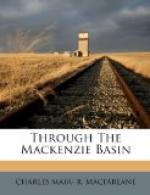Stony Creek is a tributary of a larger stream, called the Tawutinaow, which means “a passage between hills.” This is an interesting spot, for here is the height of land, the “divide” between the Saskatchewan and the Athabasca, between Arctic and Hudson Bay waters, the stream before us flowing north, and carrying the yellowish-red tinge common to the waters on this slope. A great valley to the left of the trail runs parallel with it from the Sturgeon to the Tawutinaow, evidently the channel of an ancient river, whose course it would now be difficult to determine without close examination. At all events, it stretches almost from the Saskatchewan to the Athabasca, and indicates some great watershed in times past. Hay was abundant here, and much stock, it was evident, might be raised in the district.
Towards evening we reached the Tawutinaow bridge, some eighteen miles from the Landing, our finest camp, dry and pleasant, with sward and copse and a fine stream close by. Here is an extensive peat bed, which was once on fire and burnt for years—a great peril to freighters’ ponies, which sometimes grazed into its unseen but smouldering depths. The seat of the fire was now an immense grassy circle, with a low wall of blackened peat all around it.
In the morning an endless succession of small creeks was passed, screened by deep valleys which fell in from hills and muskegs to the south, and at noon, jaded with slow travel, we reached Athabasca Landing. A long hill leads down to the flat, and from its brow we had a striking view of the village below and of the noble river, which much resembles the Saskatchewan, minus its prairies. We were now fairly within the bewildering forest of the north, which spreads, with some intervals of plain, to the 69th parallel of north latitude; an endless jungle of shaggy spruce, black and white poplar, birch, tamarack and Banksian pine. At the Landing we pitched our tents in front of the Hudson’s Bay Company’s post, where had stood, the previous year, a big canvas town of “Klondikers.” Here they made preparation for their melancholy journey, setting out on the great stream in every species of craft, from rafts and coracles to steam barges. Here was begun an episode of that world-wide craze, which has run through all time, and almost every country, in which were enacted deeds of daring and suffering which add a new chapter to the history of human fearlessness and folly.
The Landing was a considerable hamlet for such a wilderness, being the shipping point to Mackenzie River, and, via the Lesser Slave Lake, to the Upper Peace. It consisted of the Hudson’s Bay Company’s establishment, with large storehouses, a sawmill, the residence and church of a Church of England bishop, and a Roman Catholic station, with a variety of shelters in the shape of boarding-houses, shacks and tepees all around. From the number of scows and barges in all stages of construction, and the high timber




